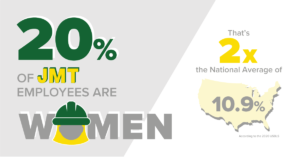I want you to imagine a bustling, noisy jobsite in your mind. The foundation has been laid, the structural beams are up, and subcontractors are milling about with tools clanking at their sides. The air around you smells like the overturned earth and lumber. You hear the consistent beat of a hammer like a woodpecker, loud orders bellowed by the superintendent, and the shuffle of feet. Now imagine the faces of the people on the jobsite. Who do you see? Did you imagine any women? If you’re like me, I’m pretty sure you imagine men, tools in hand, stomping through the jobsite.
We live in a society where we are proud to promote diverse cultures, ethnic backgrounds, and help break through barriers and glass ceilings. We demand equal pay and opportunities for all and in most cases, there are several industries that offer those gladly. However, there are several industries that may offer those benefits, yet still struggle to bring in diverse groups due to stigma or ineffective recruitment. One industry that falls in this category is construction.
According to the United States Bureau of Labor Statistics, in 2020 only 10.9% of people in construction were women, 6% were African American, and only 2% were Asian. The industry clearly has a gender and racial gap. Thought leaders and industry giants have a lot of work to do to remove the stigmatization of it only appealing to men.
When faced with a massive issue like this, it can feel that there are no simple solutions. Yet there are ways to invite more diverse groups into the industry, we just have to be willing to promote it.
J.M. Thompson’s Approach to Women in Construction
J.M. Thompson takes great pride in hiring qualified women who offer their distinct background and experience to a project. Out of our 40 employees, 20% are women including Sampada Chavan, an estimator in pre-construction, and Barbie Popp, a project coordinator. They offer a unique perspective of working in the industry, the benefits and setbacks of being a woman on the jobsite, and the misconceptions many women have regarding construction.
Sampada took a long, winding road to get to her current position within the field. Growing up in India, she remembers being inspired by her uncle, a structural engineer, who worked in public works. He was passionate about infrastructure and the growth opportunities in India and Sampada was fascinated by his stories. In high school, she watched documentaries on construction and engineering, which expanded her interest in the field.
She decided to pursue a Bachelor’s degree in civil engineering. “I had to justify to my parents, peers, and myself that I belonged in this male dominated industry and making that decision at 18 was a big deal. I had to consider: do you really want your life to be this way?” After working in civil engineering and handling design aspects of construction, Sampada desired to further her studies to gain expertise in construction management. She embarked to the United States and received a Master’s in construction management which led to her current position as an estimator in pre-construction.
“This job is a culmination of all of my interests. The opportunity to sit down with clients and add value to the discussion by giving design, cost, and schedule inputs, and present how a whole project will play out even before it breaks ground is exciting to me,” Sampada shared. Sampada currently works on pre-construction with a team of estimators on design-bid-build and construction management at risk commercial projects.
Barbie Popp began her journey to join the construction industry from the real estate side. Being a real estate agent gave her the opportunity to see the best and worst of houses and inspired her to design and build two of her own homes. “I enjoyed meeting with the builder, and loved seeing the process of construction and how the home came together. That’s where I got the taste of construction,” Barbie reflected.
Building her homes, piqued Barbie’s interest in the field of construction, so she pursued a certification in project management at UNC Wilmington. This solidified her interest in the commercial construction industry and opened up doors to work on jobsites. “My favorite part of this job is the opportunity to walk the site with the superintendent. You can see the progression of the project and how all the subcontractors contribute to each part which eventually evolves into a building. A jobsite is like a little city,” she commented.
Removing the Stigma – Misconceptions about Women in Construction
Both Sampada and Barbie have experienced both positive and negative aspects about being women within this industry, but this has only debunked many misconceptions people have about females in construction.
Sampada reflected that most often, people are incredibly sweet and kind to her because she is a female. “People are so nice to you which can be good, but then, it also makes you feel that you are not good enough. Would you be this sweet to any of the men on the jobsite? Sometimes, people assume we would not be able to handle what men can, but women can handle the pressures of the job equally.”
Barbie related that it can be intimidating to present ideas to a team predominately made of men. “You have to find your voice and be confident, then you will be respected. A female perspective, how a women looks at a project, can offer a unique approach to unforeseen challenges.”
Inspiring Women to Join the Industry
Both Sampada and Barbie want to encourage other women to join the field. You don’t have to be rugged and lose your femininity to make an impact in this industry, there are endless opportunities for a women’s perspective in construction whether that is designing, pre-construction and cost estimating, or running the project on the jobsite.
Barbie wants to inspire her two young daughters by being an example that no matter the field, women can be whatever they want. Sampada stated, “Many women love to plan and are creative. We love control in little aspects of our lives. These reasons make this a perfect industry to use some of our natural skills. We need women who can manage people and projects and are willing to offer their unique insight.”
On a broader scale, construction companies play a huge role in recruiting and cultivating more diverse workers and there are many ways they can implement effective strategies to invite more women in. One solution companies can use to remove the stigma of construction being a males-only career path is by intentionally recruiting women. Construction companies can make inclusive job postings and reach out to women and encourage them to apply. This will show that your company values women in the workforce and sees their potential to offer creativity and innovation to the construction industry.
Another way to bring in diversity is fostering relationships with MWBE firms. There are many diverse subcontractors or second tier subcontractors who need opportunities and companies who will partner alongside them. Seeking out these firms and building strong relationships with them will encourage more ethnic members to consider construction as a potential career field.
We have a long way to go, but there are many practical steps we can take to become more inclusive of all people, and continue to promote women in construction.

